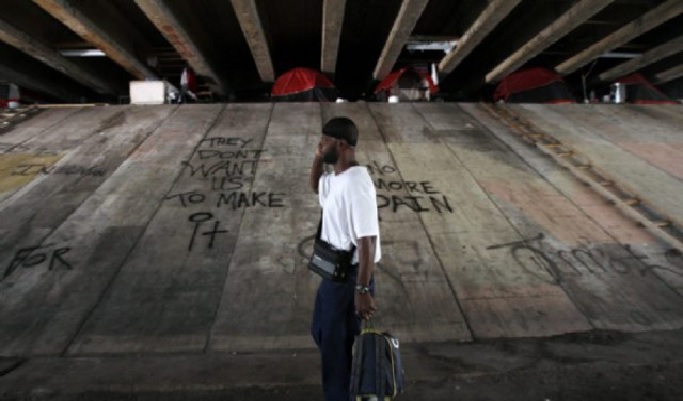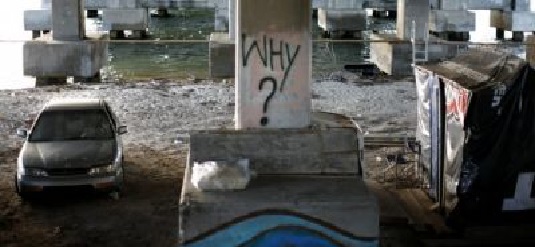The Pariahs of Miami Beach
The Pariahs of Miami Beach
By Philippe Coste, originally published on 10/29/2009 by the Express Magazine (France)
The law of a county in Florida forces pedophiles released from prison to live under a bridge, in a camp with no water and no electricity. A purgatory-slum where these outcasts have practically no chance of reinsertion.

- A convicted sex offender arrives at his tent camp under the Julia Tuttle causeway bridge in Miami, Florida February 4, 2008. (photos by REUBENS/C.Barria)
Even cops, their worst enemies, advise you to go check it out in the evening, at curfew around 22 hours when the pariahs of America go to sleep in the middle of the bay. You still have to manage to find them under the Julia Tuttle Causeway.
In daytime, at the edge of the huge highway traversing Biscayne Bay, between Miami and the beaches of Miami Beach, thousands of people driving their cars spots the oddly out of place laundry drying near the palm trees. In the evening, despite the neons lights dancing on the far out coastline, the six lanes float on a darkening void. Lacking any bearings, we drive at walking pace so we won’t miss the entry point to a muddy maintenance road that plunges under one of the bridges. It’s there.
The forest of pillars shelters a bunch of tents of all shapes and sizes, and huts, in line near the water or perched on top of the embankment up to right next to the roadway, which trembles as heavy loads go by. This american favela enjoys a billionaire’s view on the tourist paradise of Miami Beach, but the stink coming from the shore (the dump for the camp latrines), the gloomy rumbling of the generators and even the distant lightning of the september storms seem to talk about a strange damnation, the dirty secret that has been bugging Miami for more than four years.
The “people under the bridge” are all ex-convicts. Criminals, sentenced for sexual abuse of a minor less than 16 years old. And if these 50ish outcasts live here, some since many years, it’s just to obey the law. Once out of prison, the State of Florida forbade them to reside less than 1000 feet away from a school, a parc, a bus stop or any other place frequented by children. But the county of Miami-Dade, the most populated and dense urban region in the state, went even further since 2005, broadening the forbidden perimeter up to 2500 feet. This anti-crime measure makes finding any kind of housing impossible, relegating these ex-inmates in a handful of authorised places: two motels near the airport, a few isolated mobile homes, and right here, under the Causeway, on a strip of land in the middle of the bay without water or toilets. A “colony” as sordid as it is official, that intrigues tourists and irks public opinion, without managing to spark its compassion though.
Yet not all residents here have the same story. If two among them have raped children, others are lovers of pedophile photos on the Internet or exhibitionists arrested near a school. Among these men, blacks, whites, latinos, asians, who greet us or scurry away before us -there is also one woman- we even run into two guys sentenced to seventeen months of prison when they were 19 and 20 for having slept with their 15 years old girlfriend. The authorities didn’t care about the details. About 50 ex-convicts are living under the bridge.
After fifteen years of security overload, sex offenders still incarnate the main american obsession. The national database of sex offenders -pedophiles or not- includes today about 634 000 names, a crowd matching the population of Wyoming or of a metropolis like Seattle, and where we can find just about anything: rapists and torturers, students arrested for streaking -meaning running around naked on a football field during a match… 8 states still add clients of prostitutes to this registry, 13 others register for offense to modesty drunkards urinating in public. The list is accessible from the Internet and iPhone apps, providing the address and picture of any possible predator in the neighborhood, with a short mention of the charges moved against them.
This virtual mark of infamy loses them jobs and housings, as soon as their colleagues or neighbors scope them out online. To those who committed their crimes against minors, the list also means relegation.
The elder of the Causeway is 84 and lives here since 2007. Twice, he touched children who wanted to pet his little dog. The judge spared him from prison but not from being registered, for at least 20 years, on the sex offenders database. So he will probably live the rest of his life in the slum. This “papy” is so deaf that he doesn’t even hear the bips of his electronic bracelet verifying his return to base at night. “It’s a never-ending retribution to make monsters atone!” protests another camp resident, Juan Carlos Martin, a latino arrived in 2005. After six years of prison and just as many of therapy for his masturbatory urges, this pioneer of the “colony” isn’t subjected to judicial supervision anymore, but will stay on the list all his life. It was he who, on a bad day, sprayed the big “Why?” on one of the pillars.
Actually, Juan Carlos knows the answer: it lies in the legitimate public outroar caused by cases of pedophilia, and in the political arms race that follow them. In Miami, the rule of 2500 feet was born from the campaign of one Ronald Brook, whose daughter was abused by her nanny. This indignant father was also the most influent lobbyist and fundraiser in Florida. “That’s why this rat hole is my official residence”, continues Juan Carlos, showing his driver licence: it reads “Julia Tuttle Causeway” under “address”. The place woke up his anguish. He tried to end it twice, cutting his veins or jumping off the bridge.
Most of them ran away without leaving their new address
Since then, the “veteran” plays the role of guide for newcomers, sent here as soon as their released. It’s the case of Dathaniel Willis, installed since september at one end of the camp. “Even with the old restriction of 1000 feet, my parent’s house would have been in it” explains this 32 years old black man. “I was condemned to the street”. Dathaniel, accused by his ex-girlfriend of molestations on his 13 years old daughter, spent eighteen months in prison. Like the others, he wears now an electronic bracelet he recharges with the camp generator, propriety of Joe, another veteran of the colony, who bills 3 dollars a week for the fuel. An antenna, placed on the bridge by the county authorities, verifies the presence of the sex offenders under the bridge at curfew. The time, each evening, for a surreal spectacle as visitors come down from the roadway: mothers bringing pizza to their lads; spouses joining their outcast husbands to watch tv and most of the time to spend the night in their tents.
If they sleep out or are not accounted for, those on probation will be assured to serve the rest of their sentence in prison. The others, “free” but still subjected to residence restriction, would risk one year of jail. By day, they are all authorized to move freely to follow their mandatory therapy, meet their families, or work in one of the few jobs availables, at a car wash or in construction. County authorities demand that these pariahs pay with their own money the 20 dollars per therapy session and the rent for the electronic bracelet, 7 dollars a day.
“These proclamations of rigour and these rules only make sense on paper” says Jeanne Baker, local lawyer of the American Civil Liberties Union (ACLU). “They ignore the individual cases and make any reinsertion impossible”. The association doesn’t ask for the end of sex offenders’ registration nor even for their confidentiality. It just asks to bring the forbidden perimeter back to 1000 feet in the county of Miami-Dade, as it is in the rest of the state. Its appeal was rejected in october.
Sociologists and criminologists of the Lynn University in Boca Raton published in 2008 a study showing that security zones don’t have any positive impact on re-offending, and might even make things worse. “Forcing people to live like bums doesn’t help their mental stability at all” observes Jill Levenson, one of the researchers. “On the contrary, that pushes them to go off the grid and escape all control”. In fact, in 2007 the camp at Julia Tuttle Causeway shaltered 170 people; today there are less than 50. Most of them run away without leaving an address, preferring to risk prison rather than keep on living under the bridge. A couple dozens have obtained their legal transfers in other less severe counties or states. After years of red tape. To “emigrate” like that, a sex offender must be accepted by the local authorities, who all demand that he finds a job and most of all legal housing in their jurisdiction. But all the municipalities near Miami are hardening residence restrictions too, to push back the unwelcomes. Under the Causeway, their numbers are growing again. Around three more each month.
